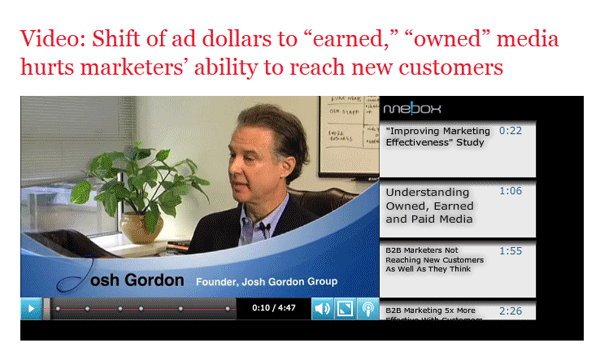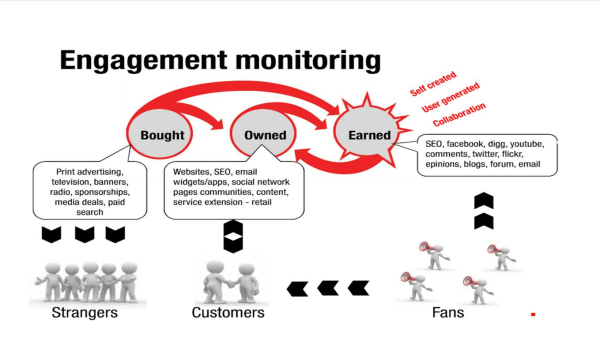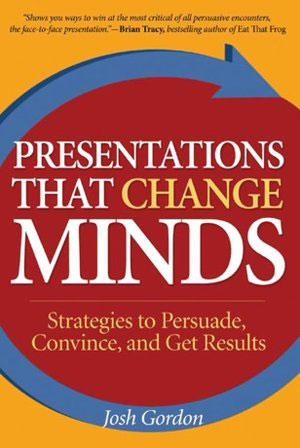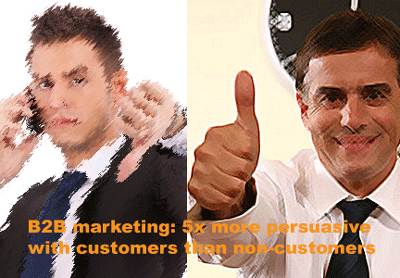What is the downside to marketers shifting media dollars out of paid media and into owned and earned media? Matt Kinsman's team at American Business Media did a great job interviewing me in this video about this overlooked topic. In the intreview I refrence findings from our recent study, "Improving Marketing Effectiveness." Click on the picture below to see the video produced using the new, innovative Me!Box interface which blends video with posted content for a richer viewing experience.
The Josh Gordon Group blog
Video: How the shift to owned and earned media hurts B2B marketing
Topics: B2B suppliers, content strategy, digital media, B2B marketing, non-customers, e-newsletter, social media, Josh Gordon Group, buyer/seller relatsionship, Josh Gordon, advertising, earned media, existing customers, noncustomers
Should your emphasis be on earned, owned, or paid media?
Bought media: media you pay for like print ads and banner ads.
Owned media: media you own and control such as your company website, blog, newsletters or digital magazines. Your organization publishes these.
Earned media: exposure you “earn” by posting content on social networks, forums, and websites that you do not own. Examples are comments posted on blogs, photos shared on Facebook, or videos uploaded to YouTube. Here is chart from a presentation from Alex Wong that illustrates these three kinds of media.
Conventional wisdom says each of these media has different strengths:
Owned media is best for reaching your current customer base. Since your organization should have the most complete list of your own customers, publishing a newsletter or digital magazine to that list should provide the best coverage available.
Bought media is best for reaching new customers. The weakness of “owned media” is that it reaches largely people who are already customers or inclined to become them. Since paid media is purchased from a 3rd party publisher you will more often find customers of competitors.
Earned media enables your biggest fans to advocate for you. Every company has customers who, if properly motivated, will advocate for you online. While this is basically an organic process that you have no direct control over, smart organizations find ways to encourage this process along. Many mistakenly think that earned media is free. While there is no charge for posting content on most social media sites, the task of doing so requires staffing for the function, and adding staff is never free.
Earned, owned, or paid media. Which should you emphasize?
If your customer are heavily involved in social media, then earned media needs your attention. If you have not asked about your customers social media involvement in a year, you need to ask again.
If you sell a utilitarian product like car batteries, or commodity products like toothpaste or paper towels, paid media might be best. When was the last time you saw a passionate blog post or successful newsletter about toothpaste?
If most of your business comes from repeat customers, you need to think more about owned media.
Different media work best for different situations. Along those lines, I prefer skim milk in my morning cereal, but 1 or 2% % for hot coca.
See Alex Wong's entire presentation on slide share
Topics: content strategy, B2B marketing, owned media, social media, non-customersr, buyer preference, buyer/seller relatsionship, advertising, BtoB, On line content, earned media, paid media
Social and digital media myopia in B2B marketing
Most organizations know their current customers very well and social and digital media are helping. By monitoring activity on social media such as Facebook pages, LinkedIn forums, and Twitter streams customer feedback flows back to organizations. Additional feedback from “owned” digital media comes in as customers interact with the company website, e-newsletter, and blog. Best of all, this feedback is free!
Topics: digital media, non-customers, social media, noncustomers, social media myopia
Better lead generation by dropping the illusion of control
Despite every sales guru on the planet telling us that the power in the buyer/seller relationship has shifted to the buyer’s side, the dialog of lead generation sounds like sellers are still in control.
Topics: buyer/seller relatsionship, lead generation, illustion of control
As a persuasive element in B2B marketing, ideas are powerful, tangible, misunderstood, and underused. I loved the first few lines from Christopher Nolan's hit movie "Inception" because they dramatize just how influential ideas can be:
Topics: Platformate, Steve Forbes, Seachange technology, B2B marketing, Shell oil, selling with ideas, Inception, Flat tax, Dell COmputer, resilient parasite
Does your current media plan reach new customers?
In today's highly fragmented communications environment your company’s media choices can become a self-fulfilling prophecy.
Topics: new custoerms, new business, non-customers, e-newsletter, advertising, media plan, existing customers
Digital magazines surprise in B2B marketing study
Some marketers have written off trade magazine advertising as yesterday's news. But a just-released study of broadcast technology buyers from the Josh Gordon Group found magazines and digital magazines among the most frequently used of all media.
Topics: B2B suppliers, B2B marketing, social media, Improving Marketing Effectiveness, iPads, LinkedIn, Josh Gordon Group, digital editions, digital magazines, trade magazines, e-readers, BtoB, Facebook, Twitter, engagement scores
Does educational content just develop customers for competitors?
There were once two competitors. The first invested to create great educational information truly helpful to customers. The second invested nothing in educational content, took the savings to the bottom line, and sold their products for less. Who won? In this case, the lower priced suppler. But it should not have happened that way.
Topics: content strategy, educational conrent, marketing strategy, buyer preference, marketing content, educational content, B2B technology marketing
Surveys in B2B marketing: are more black men in jail than college?
Surveys can add persuasive power to a marketing campaign. They sell not by overtly asking for an order, but by creating the “persuasive facts” that customers use to make buying decisons.
Call me skeptical, but having crafted hundreds of surveys that sell, when I hear a "persuasive fact" I want to know who created it, what bias it has, and what its creators are trying to sell me.
Here is one such "fact" I've heard for years:
"There are more black men in prison than in college."
Do you believe it?
This "fact" was used by several candidates during the 2008 presidential campaign (including the guy who won) and is accepted as true in many social discussions. But the "fact" should not have been used. Let's take a look at how this "fact" came to be:
Topics: selling with surveys, B2B SEO, surveys that sell
B2B marketing is 5x more persuasive with customers than non-customers
Topics: B2B suppliers, B2B marketing, non-customers, John Luff, HD Consulting, Tom Canavan, Signiant, Improving Marketing Effectiveness, Josh Gordon Group, B2B technology marketing, Josh Gordon










